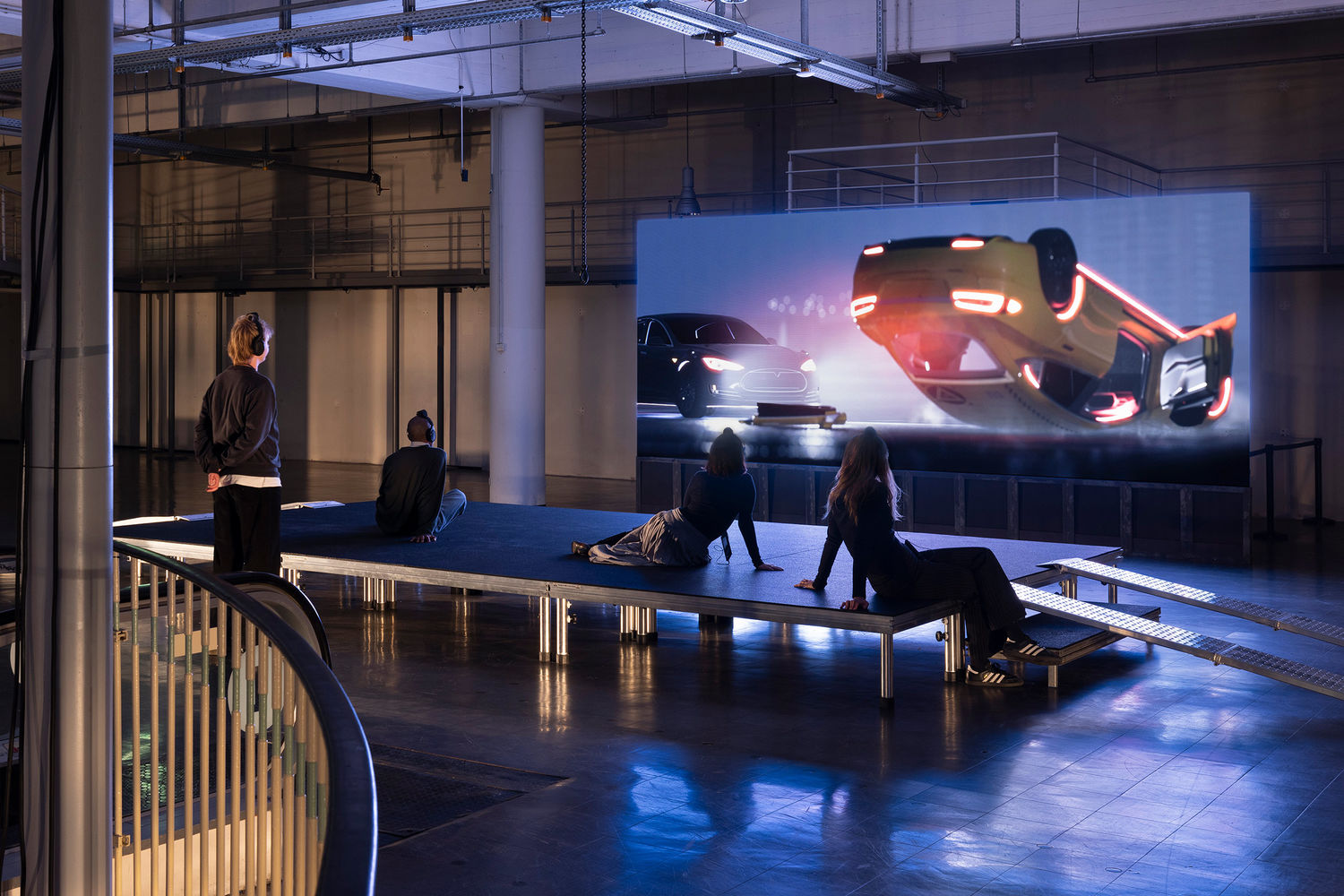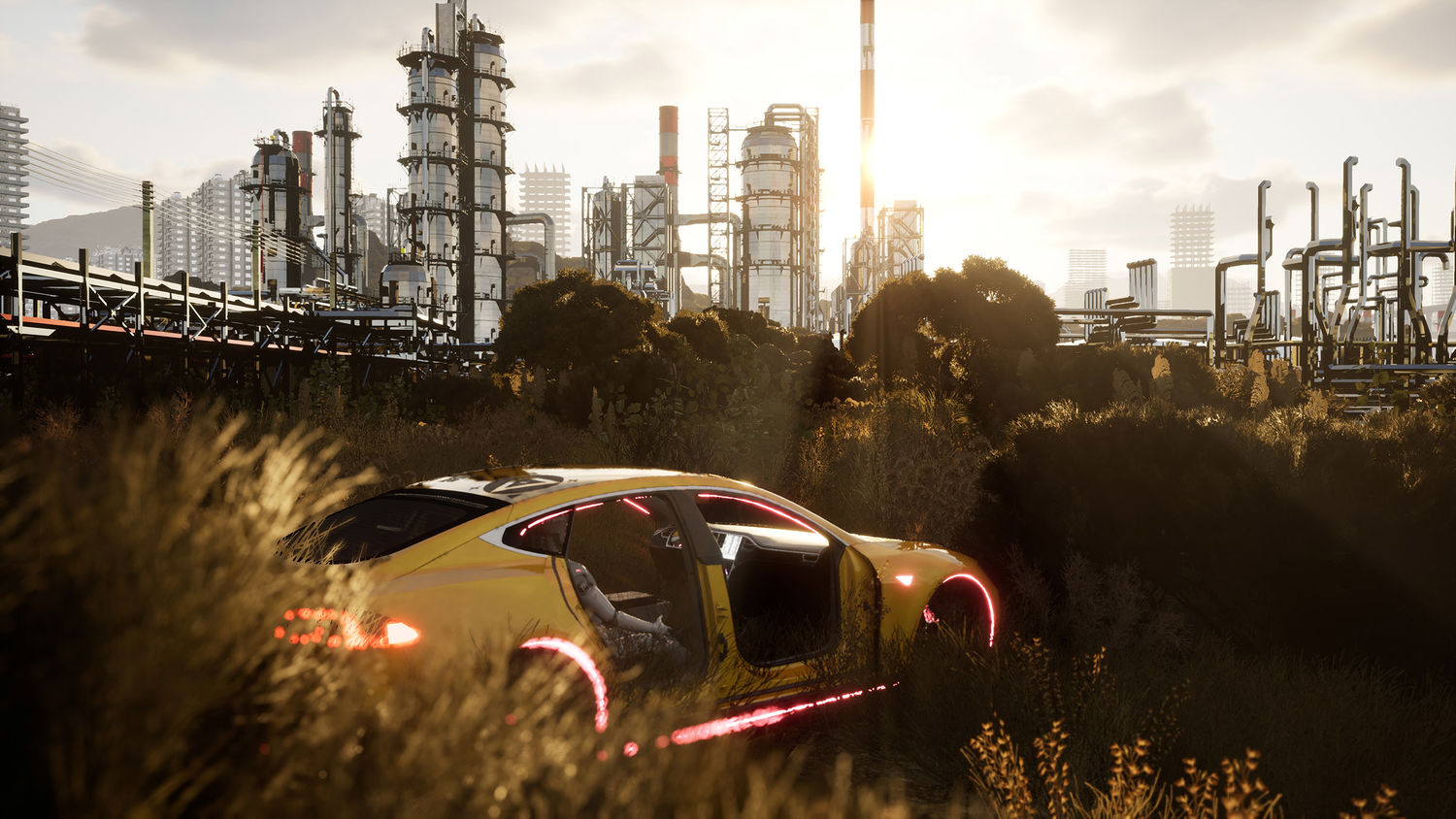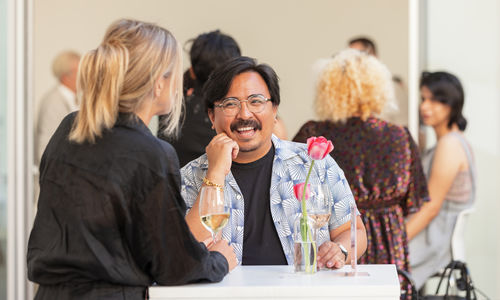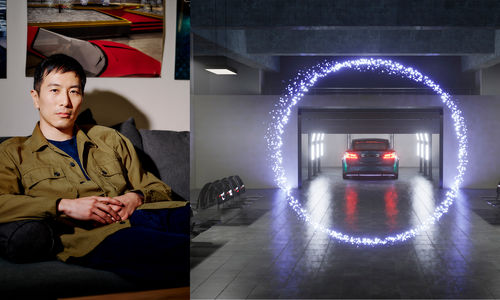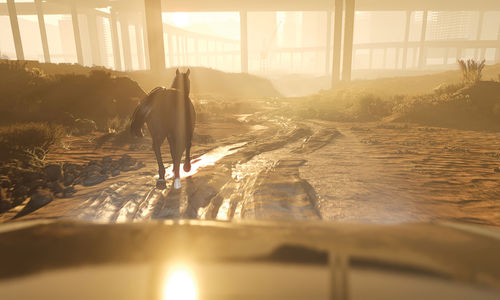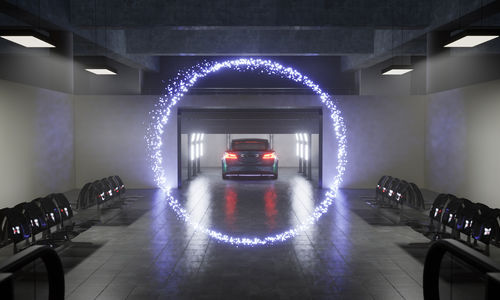
Lawrence Lek: NOX High-Rise
- – This is a past exhibition
Lawrence Lek (b. 1982) is a London-based artist, filmmaker, musician, and interactive designer. His practice engages speculative fiction through media installations, narrative soundscapes, sci-fi mythologies, and game design. Lek imagines the architecture, design, and engineering of future scenarios in which the limits between humans, machines, and artificial intelligence (AI) have been blurred.
In Lek’s immersive installation, NOX (2023), time-based media and scenography intersect to evoke a virtual world in which AI systems dominate the lives of humans and machines. In the installation’s universe, NOX, short for "Nonhuman Excellence," is a therapeutic center controlled by Farsight Corporation––a fictional AI conglomerate––where sentient self-driving cars with mental health problems are trained and treated to be put back into service. Lek´s work considers the ethical and political implications of the development of artificial consciousness in a world shared by humans, more-than-humans and machines.
Essay
Lawrence Lek interviewed by Pablo José Ramírez
Pablo Ramírez: Lawrence, would you share about your background and your interests in architectural design and video games?
Lawrence Lek: I was born in Germany in the early '80s. My parents worked for an airline, so we moved around a lot when I was young. I grew up in Hong Kong and Singapore during the 1980s and moved to London in the early 1990s. I was always interested, long before I knew formal artistic terms, in architecture as world-building in relation to Southeast Asia. This idea that the country, the city, and your own personality are all developing and merging at the same time. Growing up, I experienced the contexts of Hong Kong before its handover to China and of Singapore as a relatively young postcolonial nation-state.
I didn’t realize until later that they were going through a process of building their own identities, looking for a sense of self in the wake of disappearing structures. The experience of inhabiting virtual worlds in video games and on the internet, while actual cityscapes were changing in front of my eyes, made me aware that there’s not much separation between what in the West is called “utopian” and urban design. This consciousness was tied to a coming-of-age process, both for myself and for the nation-state.
PJR: Going back to London in the 1990s, what do you make of your generation, which is one that experienced the before and after of the hegemony of the digital world?
LL: I think there’s a general tendency for the age that you live in to be quite invisible until later. I work in multiple disciplines, so the relationship of digital culture to each of those disciplines—let’s say architecture, music, visual art, and filmmaking—doesn’t operate on the same timeline. I’ve observed that sonic cultures and music are often the first art forms to really make use of new technologies—whether that’s for recording, for making instruments, or for distribution of the work.
I was a late entrant into the world of visual art because I was focusing more on experimental architecture and music. I am of a similar age as post-internet artists, but I had a different trajectory and understanding of the tools. Architecture, like music, requires new technologies to develop.
The tradition I was taught in architecture was very much the experimental paper architecture of Daniel Libeskind, Lebbeus Woods, and Zaha Hadid, which is about the vision of a building and not necessarily its physical form. Digital culture and computers were absolutely instrumental in building a new visual idea of architecture in the 1980s and 1990s, and construction later caught up to make those visions into reality.
When I was starting to make virtual worlds, I didn’t think there was anything special about digital visualization because that’s what property developers used all the time. There was also not much novelty regarding digital synthesis because that’s what electronic musicians had been doing for decades. This gave me quite a different perspective from other artists I knew who were dealing with digital technologies in visual arts.
PJR: I agree that sound and music have been in the avant-garde of aesthetic and technical experimentation. I’m curious about your take on the contemporary art world in terms of the constraints but also the spaces of freedom that you might find. One of the things I find most compelling about your practice is how you move across disciplines. In your view, how is it that your practice resists the exclusivity of cinematic representation? And what do you find most compelling—but at the same time most frustrating—about contemporary art in relation to your practice?
LL: There’s a culture of experimentation in visual art, across both form and content, which is not always the case in other art forms. And there’s an academic, critical, and theoretical ecosystem that can support experimentation. There’s a financial support system—residencies, museum collections, grants, teaching—as well. That’s a rare combination. Being an artist lets me move between disciplines in a way that I find helpful, and that is something I was always inspired by when looking at artists of different generations. I’m drawn to this idea of art that’s not a singular discipline branded through a certain style of work. Digital culture, 3D, all these emerging forms, that’s the vernacular that holds a space of possibility for me.
PJR: Connecting to this idea of the vernacular and AI, in the last few years, we have witnessed a different public conversation. Suddenly we all feel that we should be more informed about AI because it touches our daily lives, although the concept and the research have been around for a while. What is your reaction to all this?
LL: There were two big ideas about digital culture when I was growing up. One was AI, the idea of a future being, and the other was virtual reality, the idea of a hallucinated simulated world that everyone’s going to inhabit. In a way, virtual reality ended up becoming my medium. I’m building simulations of speculative worlds that comment on our own, which goes back to the idea of science fiction as social critique. For me, AI is the protagonist of this world, the character I’ve chosen as an avatar to inhabit these worlds.
In 2016 I was doing research for Geomancer (2017), a film about an AI satellite that returns to Singapore in the year 2065 because it wants to be an artist. I was researching East Asia, Singapore, China, and AI, and I was struck by the fact that unlike Afrofuturism—which has a rich body of work, discourse, theory, criticism, and cultural production around it—there was a void in terms of similar things to do with China and AI. I made a video essay called Sinofuturism (1839–2046 AD) (2016) that draws parallels between the representation of AI and the representation of China. These two things were discussed in strangely similar ways, as either something that’s going to save us or something that’s going to destroy us.
China is always portrayed as being good at computing, good at video games, capable of endless labor, yet incapable of originality and able only to copy things. You see echoes of this now with DeepSeek and OpenAI. Fast-forward nearly nine years after Geomancer, and it’s strange to see that the topics are even more current. Could I have foreseen that these things would still be of continuing relevance? I don’t know. China versus the West is still current. But Sinofuturism is not tied so much to Chinese identity; it’s tied more to this idea that culture is a life force. It’s a means of reproducing itself. It’s like a virus.
PJR: Futurisms as a philosophical and aesthetic practice, as you noted, have lacked critical production in Asia, which could also be said of other parts of the Global South. In a way, futurisms and the academic and cultural movement around speculative realism took shape mostly in some circles in the US and Europe but especially in London in the early 2000s.
Would you share more about your ideas on speculation and fiction?
LL: The author Margaret Atwood defines her writing as speculative fiction rather than science fiction. She says that the events in her work, strange and terrible as we find them, have happened to somebody at some point in history. My idea of futurism is about imagining how the future can already be glimpsed in our present reality. I’m just changing some scenes, some details. The world-building, if you think about it in terms of literary theory, is allegorical. Sometimes it’s a cautionary tale: Don’t make a full-control surveillance society because it’s going to be cruel. If you value democracy and human rights, you shouldn’t make that kind of society.
Some of my work does have this aspect of social commentary. In Geomancer it’s like I’m saying, “If you create these self-aware beings and they serve you well, it’s logical to think that they’re going to look for freedom.” One of the cruel paradoxes with AI is that we might be creating the most intelligent being ever, but we are also destroying them at the same time. And how can they not become aware of that? If we crash test millions of cars until we make the perfect self-driving car, how is that essentially that different from animal testing?
Morally, we should try to be self-aware about these conscious things that we make. The other reason I think speculative fiction is important is that trying to be optimistic about the future is very, very difficult in 2025, when we’re overwhelmed by the bleeding of technology and investment into political forces.
PJR: This gives us a chance to talk about NOX in relation to these ideas and your broader thoughts about the series. Do you want to start by introducing the project at LAS Art Foundation in Berlin, where it debuted? This project is also a synthesis of ideas that were present in previous projects, right?
LL: I work episodically, so each project builds on the last. I jokingly call it a “cinematic universe,” with recurring themes and characters, like a science fiction saga or video game with expansion packs. The original Sinofuturism series was set forty years in the future. Whereas, with NOX, which is the second episode in the Smart City trilogy, I was thinking about setting it in the near future. In the first episode, Black Cloud, a city surveillance AI talks to its built-in AI therapist to figure out why it’s so depressed.
It turns out that it was because the surveillance AI had just reported everyone for breaking the rules, and now the city’s abandoned. When I was invited to do a commission at LAS, I wanted to continue the story by transforming a former shopping center in Berlin into a rehabilitation center for disobedient self-driving cars. I called it NOX, an acronym for the AI company Farsight’s program for “Nonhuman Excellence,” but also nox is Latin for “night,” which would make sense for a moody noir atmosphere. At the same time, I was thinking of how to realize this cinematic idea into an architectural space. In the LAS version of NOX, visitors get headphones that track their location in the building, and as they move into different zones, a new voice-over narrative starts playing. It’s like a physical version of an open-world video game, like a role-playing game in which you enter different zones and you figure out the story. As the visitor moves through the space, they come to understand the five-day journey of a self-driving car called Enigma-76.
PJR: Could you share a little more about this new chapter of the project, the installation at the Hammer?
LL: With the exhibition at the Hammer, I really wanted to reference the architectural language of Los Angeles or at least the myth of cinematic Los Angeles. In my installations I try to evoke this kind of universal place that’s shared by film sets and video game environments, where the location you inhabit is both highly specific and completely generic. A liminal zone. I thought that the Hammer installation could evoke a corporate apartment, the kind that a Farsight engineer might stay in when they visit the smart city to test the cars. There are new-media and sculptural elements, commissioned for the Hammer exhibition, shown alongside the videos and game that were shown in the previous edition of NOX. The whole exhibition runs on a continuous loop, so it feels like you’re stepping into this stage set that’s been running forever. Part dream, part machine.
Whereas the Berlin version focused on the external cityscape, at the Hammer it’s bringing you into the world of a corporate employee, the kind of person who lives in the realm of technological exchange and AI development. Films create empathy by portraying characters on-screen. Games do that by giving the player some kind of power or agency. With my work, I’m really interested in creating relationships where the audience is simultaneously a player and a participant.
PJR: NOX, like many of your previous projects, has a profoundly affective and psychological dimension. That’s in part because you are trying to make manifest a certain ontology that is not exclusive to humans. One of the first questions that people might ask when they see your work, especially NOX, is what role humans play in these worlds. Where is the human voice?
LL: In these works that have a non-human-centric story, the main role of the human is to witness and to be the player. What do I mean by that? Images with a human figure immediately put us in a place of empathy or identification or judgment about the human. This is a well-explored problem in art history. Of course, with the invention of perspective, there was the idea that the viewer, the eye outside the picture frame, is the most important part of the encounter with art.
You may have human figures inside the frame, but it’s both the viewer and the work that constitute the work of visual art. With music, the presence of the human is also an interesting question. For example, you have instrumental music where humans are the performers, and you have songs with singers telling you stories about humans. But with electronic music there’s often no singer, or if there is a singer, it’s often an artificial voice or a clearly sampled and repeated voice. Some people love ambient music and instrumental electronic music, and if you were to ask them where the human is, then clearly the human’s role is as the listener. In a similar way, with a lot of my films and games and installations, the human aspect is literally what you bring to the encounter. It’s what you perceive as the player or viewer or spectator.
Lawrence Lek is organized by Pablo José Ramírez, curator, with Jessi DiTillio, curatorial assistant.





